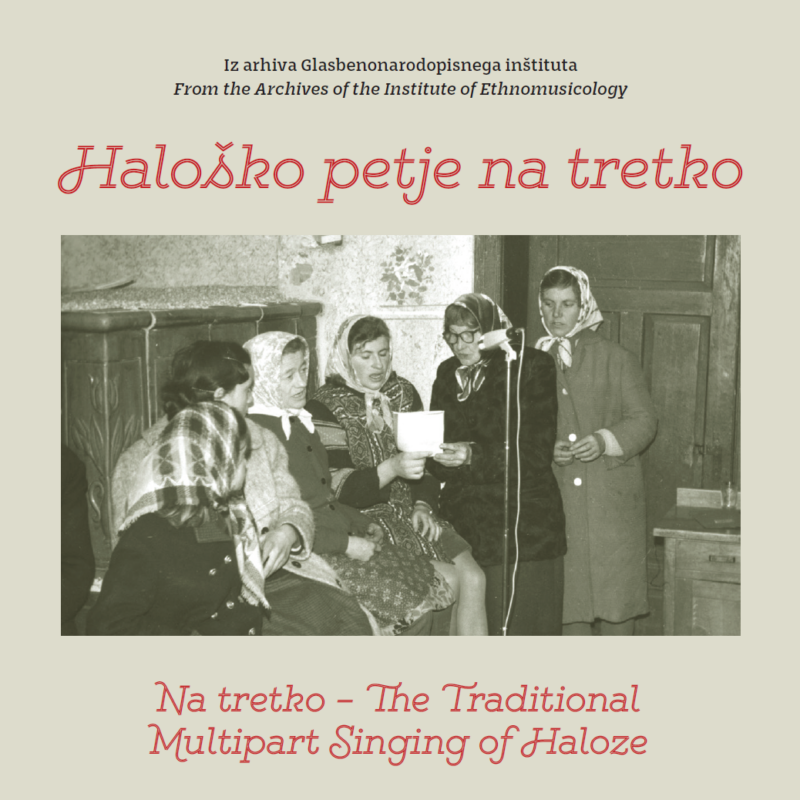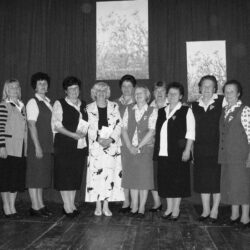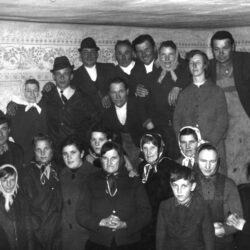Na tretko: The Traditional Multipart Singing of Haloze

GNI M 30.069
Recorded: Velika Varnica, 1969
Sung by: Marija Emeršič, Gizela Kozel, Marija Krajnc, Micika Krajnc, Cilka Šmigoc, Anica Vidovič
GNI M 30.036
Recorded: Velika Varnica, 1969
Sung by: Vilko Ivančič, Martin Krajnc, Jože Turk and others
GNI Podlehnik, 13. 11. 2015, Štaj./3
Recorded: Podlehnik, 2015
Sung by: Trstenke Society (Helena Gabrovec, Kristina Habjanič, Danica Jelen, Milka Jelen, Marica Junger, Marija Jus, Angela Krajnc, Anica Lozinšek, Lojzka Merc, Tinka Merc, Olga Šega, Jožica Trafela)
GNI M 31.180
Recorded: Sedlašek, 1970
Sung by: Malika Ferš, Mila Jelen, Marica Rodošek
GNI M 30.054
Recorded: Velika Varnica, 1969
Sung by: Marija Emeršič, Vilko Ivančič, Gizela Kozel, Marija Krajnc, Martin Krajnc, Micika Krajnc, Jože Turk, Anica Vidovič
GNI Cirkulane, 9. 9. 2009, Štaj./9
Recorded: Cirkulane, 2009
Sung by: Folk Singers from Cirkulane (Ivan Hercog, Franc Korenjak, Jože Petrovič, Terezija Petrovič, Danijel Polajžer, Tonček Žumbar)
GNI Podlehnik, 13. 11. 2015, Štaj./6
Recorded: Podlehnik, 2015
Sung by: Trstenke Society (Helena Gabrovec, Kristina Habjanič, Danica Jelen, Milka Jelen, Marica Junger, Marija Jus, Angela Krajnc, Anica Lozinšek, Lojzka Merc, Tinka Merc, Olga Šega, Jožica Trafela)
GNI M 30.151
Recorded: Gruškovje, 1968
Sung by: Franček Habjanič, Jakec Habjanič, Simon Habjanič Jr., Simon Habjanič Sr., Stanko Habjanič, Tevžek Habjanič, Tunek Habjanič, Tunek Habjanič
GNI M 31.177
Recorded: Sedlašek, 1970
Sung by: Malika Ferš, Mila Jelen, Marica Rodošek
GNI M 33.005
Recorded: Trdobojci, 1971
Sung by: women and men celebrating golden wedding anniversary
GNI Podlehnik, 13. 11. 2015, Štaj./5
Recorded: Podlehnik, 2015
Sung by: Trstenke Society (Helena Gabrovec, Kristina Habjanič, Danica Jelen, Milka Jelen, Marica Junger, Marija Jus, Angela Krajnc, Anica Lozinšek, Lojzka Merc, Tinka Merc, Olga Šega, Jožica Trafela)
GNI M 31.063
Recorded: Sedlašek, 1970
Sung by: Malika Ferš, Mila Jelen, Marica Rodošek
GNI M 30.056
Recorded: Velika Varnica, 1969
Sung by: Marija Emeršič, Vilko Ivančič, Gizela Kozel, Marija Krajnc, Martin Krajnc, Micika Krajnc, Jože Turk, Anica Vidovič
GNI M 30.062
Recorded: Velika Varnica, 1969
Sung by: Vilko Ivančič, Martin Krajnc, Jože Turk and others
GNI Podlehnik, 13. 11. 2015, Štaj./4
Recorded: Podlehnik, 2015
Sung by: Trstenke Society (Helena Gabrovec, Kristina Habjanič, Danica Jelen, Milka Jelen, Marica Junger, Marija Jus, Angela Krajnc, Anica Lozinšek, Lojzka Merc, Tinka Merc, Olga Šega, Jožica Trafela)
GNI Cirkulane, 9. 9. 2009, Štaj./11
Recorded: Cirkulane, 2009
Sung by: Folk Singers from Cirkulane (Ivan Hercog, Franc Korenjak, Jože Petrovič, Terezija Petrovič, Danijel Polajžer, Tonček Žumbar)
GNI M 30.344
Recorded: Velika Varnica, 1969
Sung by: Vilko Ivančič, Janko Krajnc, Francl Krajnc, Viktor Krajnc, Konrad Šmigoc
GNI Podlehnik, 13. 11. 2015, Štaj./7
Recorded: Podlehnik, 2015
Sung by: Trstenke Society (Helena Gabrovec, Kristina Habjanič, Danica Jelen, Milka Jelen, Marica Junger, Marija Jus, Angela Krajnc, Anica Lozinšek, Lojzka Merc, Tinka Merc, Olga Šega, Jožica Trafela)
Urša Šivic: Na tretko – The Traditional Multipart Singing of Haloze
Memories of singing na tretko in Haloze
The singing style of Haloze, known as na tretko represents a more prominent characteristic of Slovenian soundscapes. It is popular among revival singing groups and is also of interest among experts in the ethnomusicological field. In order to set the theoretical fundamentals of na tretko singing and to present recordings that are not yet very well known, we have decided to carry out a more comprehensive study. The publication of the monograph Haloško petje na tretko is a part of this project. The audio publication of the same name, while it can be seen as an independent publication, accompanies the monograph: it provides sound – a dimension that cannot be replaced even by the most vivid description expressed in words.
Several authors cooperated in the research of na tretko singing in Haloze: Lojzka Merc, Jasna Vidakovič, Mirko Ramovš in Urša Šivic (see Šivic, 2017). As the leader of the female singing group Trstenke, Lojzka Merc proved to be the key initiator of the revival of na tretko Her singers were familiar with this type of singing from their youth, but by the time they became active singers themselves, na tretko singing had become all but obsolete. Lojzka Merc’s wish came true: her goal had been to revive this type of singing as it had been preserved by the group Pevke iz Velike Varnice (Singers from Velika Varnica) – “the last who still sang this unique singing wonder, preserved in the steep parts of Haloze” (Merc, 2017: 9).
It was the singers from Velika Varnica that Mirko Ramovš and Jasna Vidakovič spoke about in their memories. Mirko Ramovš, today a retired researcher of the Institute of Ethnomusicology, first got acquainted with na tretko singing during his field work. He spent time recording in Velika Varnica on 9 March 1969 on the Pri Zveličarju homestead. A local woman, Nežka Vaupotič, organised singers to take part in the recording sessions of the institute’s associates. At that time Nežka Vaupotič co-operated with the Institute and recorded for its archives in Haloze and Prlekija. Apart from rich song traditions, the field work in Haloze revealed an interesting singing phenomenon: “in some songs […] a fourth [voice] rose above the usual three, na ‘čriez’ (“across”), which again was a surprise as we did not expect to find it in Haloze. The unusual, somewhat sharp but natural sound of the four-voice multi-part singing of Haloze, especially the female vocals, virtually enchanted us” (Ramovš, 2017: 12).
Mirko Ramovš was often asked to organise suitable music groups for various events. It was on his initiative that the five singers he met during the recording sessions in March 1969 formed an independent music group. They simply called themselves Pevke iz Velike Varnice. In the subsequent years they performed throughout Slovenia and elsewhere, spreading Haloze na tretko singing (cf Meško, 2011: 11–14). They first performed in public in 1975 at the International Folklore Festival in Zagreb. On the stage of the Vatroslav Lisinski concert hall, the five women were almost invisible, “but when they sang, the hall fell silent and their sharp, but moving, multi-part singing filled the hall and amazed the public” (Ramovš, 2017: 13).
A long-time editor of folk music on Radio Slovenia, Jasna Vidakovič played an important role in the popularisation of the Haloze style of singing. In 1973 she organised a studio recording session with the Pevke iz Velike Varnice. These recordings took “the Haloze way of singing na tretko across the world” (Vidakovič, 2017: 16). As an editor, she included the recordings in radio broadcasts, radio competitions and in audio publications. In this way, na tretko singing “has become a valuable exhibit in a kind of a museum of the spiritual culture of Haloze” (Vidakovič, 2017: 16).
About singing na tretko in Haloze
Judging by the rather large number of recordings and from the quality of the singing, na tretko singing was still a living musical practice in Haloze at the beginning of the 20th century, although we can still assume that the Institute’s associates managed to capture a disappearing music tradition. In recent years the singing group Trstenke from Podlehnik, along with the Sestre Kopinske singers from Cirkulane, has started to revive na tretko singing. On the other hand, Folk singers from Cirkulane, and another singing group, Pevci Kopači from Podlehnik, has transferred this way of singing from their home environment to that of organised group singing.
Among the types of multi-part singing popular in Slovenia, na tretko singing was often mentioned by researchers. However, they did not go into a more detailed description of tretka and its role in the structure of a song. The researchers would describe tretka as singing whereby “[…] a higher voice rises above the voice that originally sings above the others!” (Strajnar, 1992: 26) The singers themselves defined it as the voice that “sings a little up and a little down” (Kumer, 1975: 103). One of the reasons for an insufficient theoretical definition of this Haloze type of singing is that it was discovered rather late. One enthusiastic remark by Valens Vodušek, one of the first researchers of singing in Haloze went “The most surprising recent event was the discovery of an exceptionally strong centre of this older style of singing in Haloze, in the area near the Croatian border” (Vodušek, 2003 [1970]: 97).
Talking about the first recordings of na tretko singing, we need to mention Nežka Vaupotič from Haloze, who cooperated with the Institute of Ethnomusicology in the years between 1968 and 1972. Nežka Vaupotič borrowed a tape recorder from the Institute and recorded the instrumental and vocal traditions of Haloze and Prlekija for its archives (cf Kunej, 2016: 83). Consequently, the first recordings of na tretko singing were made in Haloze in autumn of 1968. In March of the following year, Nežka Vaupotič organised field recordings for the Institute’s associates. Especially notable was a session of March 9th in Velika Varnica on the Pri Zveličarju homestead, which brought together many of singers from the surrounding area.
Na tretko singing is a four-part type of singing. Examples can be found among audio recordings from Gorenjska, Bizeljsko, Haloze, the Upper Savinja Valley and from both Austrian and Slovenian Carinthia. All examples of na tretko singing have one thing in common: a third voice above the bass. The expression ‘na tretko singing’ is the result of an agreement; the expression was established as part of ethnomusicological and folklore language. However, researchers did note other dialectal expressions used to describe this type of singing: iber (from the German über, meaning over), cvik (presumably either from the German zwicken, meaning to pinch, or the Slovene cvikati meaning to chirp), drajar (from the German dreier, the third), treka or trek ton, meaning the third (cf Kumer, 1975: 102). The most commonly used expressions in Haloze are prek, črez and iber; they convey two ideas; first, this is the third voice singing above the bass; second, this is the highest voice.
Although, in some places na tretko singing is considered a music practice of lads’ or men’s groups, the audio recordings of Haloze na tretko singing from the archives of the Institute of Ethnomusicology show that both men and women were able to sing in this way. Tretka was therefore not restricted by gender or number of singers gathered: it could be sung either by a man or by a woman, but it was always sung by one singer only. As in the past, in contemporary, mostly organised singing groups it is possible that a female voice replaces a male one in an otherwise all-male singing group (for example tracks 6, 16).
In the 1960s and early 1970s, na tretko singing was still an everyday singing practice. However, this skill was not thoroughly passed down to younger generations. One of the reasons this practice was being abandoned is that large numbers of people moved away from Haloze during the post-war period. A smaller number of people and a different way of making a living led to weakening of local singing abilities. We also need to take into account the changed aesthetic norms in music, especially those that were introduced through radio, pop folk music and also choir singing – at that time mostly represented by church choirs. Na tretko singing had no special value at that time. Generations born after the Second World War saw this type of singing as old-fashioned and outdated (Kokol, 2016).
The impressions of several female singers born after the Second World War reveal the assumption that na tretko singing was not considered beautiful at that time. The singers remember this type of singing from their youth as “screaming” or “squealing” (Merc 2016, Kokol 2016). Here we have to mention another distinguishing characteristic of na tretko singing in Haloze, that is its sound. In 1969 Valens Vodušek wrote this for the radio show Slovenska zemlja v pesmi in besedi (Slovenia in Word and Song): “But in Haloze they sing loudly, often with clenched throats, in the old way, similarly as in Rezija. This renders their voices shrill and penetrating, but at the same time extraordinarily captivating” (Vodušek, 1969).
Vodušek corroborated this with a recording of the song Šla bom na goro visoko (for example track 1), which in time became a model of the Haloze type of singing. Still, this does not mean that this way of singing was generally prevalent in Haloze. By publishing lesser known recordings, this audio publication aims to present different sounds of singing in Haloze. It has to be said that the recordings on the audio publication are of varying technical quality, due to the different circumstances in which they were made, as well as due to the characteristics of the recording equipment of the time.
About the tretka voice structure
The purpose of the tretka voice is to provide sound variety to the vocal performance and to add to the harmonic structure. The tonal scales of tretka are different, while the two middle tones are always the basic tone (8) and the fifth of the eight tone major scale (5). In this structure tretka is similar to the bass voice, as – just like the bass – it moves around the basic tone and the fifth.
Musical-analytical insight into the structure of tretka reveals several different methods of composition. We could talk about the basic form of tretka, whereby the highest voice “just” harmonizes with the lower melodic voices. In this case, tretka would only move on the basic tone and in the fifth. However, no such case can be found in practice, because the two main tones are joined by other tones. Most often a sixth, in the form of a melodic figure in the sequence 5–6–5, is added to the basic line of tretka. This figure always comes in cadence, at the end of melodic phrases (for example tracks 11, 15).
The seventh characterizes the structure of tretka significantly and it represents the dominant chord; its role is that of the leading tone and it resolves into octave (7–8), or down into fifth (7–5). Audio recordings show that the seventh was established as a crucial tone in the tonal structure of tretka (for example tracks 1, 4, 12, 18). There are many cases where a seventh does not change into octave; through melodic figure 7–6–5 in cadences it changes down (for example tracks 2, 6, 7, 16, 17). The main tone is usually the middle tone of tretka, but in some cases it is not the highest as tretka reaches above it, on the ninth (for example tracks 13, 17).
Most of the audio examples of na tretko singing include, besides the main tone and the fifth, also other tones. These introduce harmonic variety, and soften the “unmelodiousness” of the main form of tretka.



